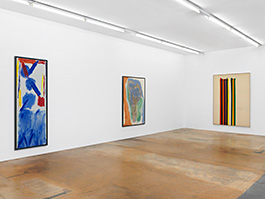
| français I english |
| Collections / January 30, 2017— |
|
Abstract Expressionisme Helen Frankenthaler, Robert Motherwell, Ray Parker, Morris Louis |
|
During the premises of the Second World War, numerous artists gathered together in New York where they created what became the first important American Art “School” of the 20th century: Abstract Expressionism. Well informed about the work of the European avant-gardes, in particular Cubism and Fauvism, they were also associating with artists who had fled Nazism and the war, in particular professors of the first Bauhaus and the Surrealists. The abstraction defended by the first and the exploration of the psyche attempted by the latter constituted the foundation from which Abstract Expressionism developed its own singularity. Arshile Gorky, an Armenian immigrant living in New York in 1920, was one of the first to implement this new plastic language. His influence became paramount, in particular the spontaneity and formal freedom transpiring through his work. Robert Motherwell, ten years younger, was also meeting with the exiled Surrealists. Peggy Guggenheim incited Motherwell, who was an art historian and theorist before he became a painter, to try out collage for a 1943 exhibition. He subsequently used this medium throughout his career, concurrently with his painting. In 1958, Motherwell married Helen Frankenthaler, who is also included in this exhibition. Frankenthaler played a pivotal role on the New York scene bridging the gap between the first generation, working at the end of the 1930s, and the emerging artists from the second half of the 20th century. Morris Louis, who visited her studio in 1953 said about her that she embodied “a bridge between Pollock and what was possible.” Just like Pollock, she worked on a canvas lying on the floor without a chassis, but she applied a very diluted paint, thus creating images without any thickness. Louis appropriated this technique while leaving large parts raw between the color stripes. Ray Parker, who, like Frankenthaler, also exhibited at gallery Tibor de Nagy, summed up what he then called “direct painting”: “The process of painting is improvised. Its rhythm can be slow or hastened, and its character impulsive or reasoned. The subject of the painter is the painting, and the subject of the painting is the artist himself, whose experience is consumed within the creation process.” |
 |
 |
|
Views of the exhibition dedicated to Abstract Expressionism, from left to right: Kimber Smith, Je t’aime, 1973, MAMCO coll., Robert Motherwell, Untitled, 1960, Photos : Annik Wetter—MAMCO, Geneva. |